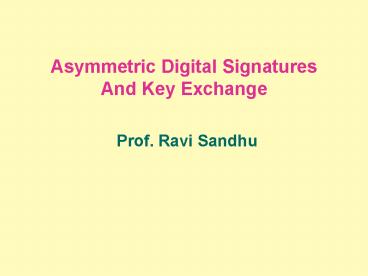Asymmetric Digital Signatures - PowerPoint PPT Presentation
1 / 22
Title:
Asymmetric Digital Signatures
Description:
RSA has a unique property, not shared by other public key systems ... yA=axA mod p. public key. private key. xA. private key. xB. yB=axB mod p. public key ... – PowerPoint PPT presentation
Number of Views:52
Avg rating:3.0/5.0
Title: Asymmetric Digital Signatures
1
Asymmetric Digital Signatures And Key Exchange
Prof. Ravi Sandhu
2
DIGITAL SIGNATURES
INSECURE CHANNEL
Plaintext Signature
Yes/No
Plain- text
Signature Algorithm S
Verification Algorithm V
A
B
A's Public Key
A's Private Key
RELIABLE CHANNEL
3
COMPARE PUBLIC KEY ENCRYPTION
INSECURE CHANNEL
Plain- text
Plain- text
Ciphertext
Encryption Algorithm E
Decryption Algorithm D
A
B
B's Private Key
B's Public Key
RELIABLE CHANNEL
4
DIGITAL SIGNATURES IN RSA
- RSA has a unique property, not shared by other
public key systems - Encryption and decryption commute
- (Me mod n)d mod n M encryption
- (Md mod n)e mod n M signature
- Same public key can be use for encryption and
signature
5
EL GAMAL AND VARIANTS
- encryption only
- signature only
- 1000s of variants
- including NISTs DSA
6
NIST DIGITAL SIGNATURESTANDARD
- System-wide constants
- p 512-1024 bit prime
- q 160 bit prime divisor of p-1
- g g h((p-1)/q) mod p, 1lthltp-1
- El-Gamal variant
- separate algorithms for digital signature and
public-key encryption
7
NIST DIGITAL SIGNATURESTANDARD
- to sign message m private key x
- choose random r
- compute v (gr mod p) mod q
- compute s (mxv)/k mod q
- signature is (s,v,m)
- to verify signature public key y
- compute u1 m/s mod q
- compute u2 v/s mod q
- verify that v (gu1yu2 mod p) mod q
8
NIST DIGITAL SIGNATURESTANDARD
- signature does not repeat, since r will be
different on each occasion - if same random number r is used for two messages,
the system is broken - message expands by a factor of 2
- RSA signatures do repeat, and there is no message
expansion
9
DIFFIE-HELLMANKEY AGREEMENT
yAaxA mod p public key
yBaxB mod p public key
A
B
private key xA
private key xB
k yBxA mod p yAxB mod p axAxB mod p
system constants p prime number, a integer
10
DIFFIE-HELLMANKEY ESTABLISHMENT
- security depends on difficulty of computing x
given yax mod p - called the discrete logarithm problem
11
MAN IN THE MIDDLE ATTACK
A
C
B
12
CURRENT GENERATION PUBLIC KEY SYSTEMS
- RSA (Rivest, Shamir and Adelman)
- the only one to provide digital signature and
encryption using the same public-private key pair - security based on factoring
- ElGamal Encryption
- public-key encryption only
- security based on digital logarithm
- DSA signatures
- public-key signature only
- one of many variants of ElGamal signature
- security based on digital logarithm
13
CURRENT GENERATION PUBLIC KEY SYSTEMS
- DH (Diffie-Hellman)
- secret key agreement only
- security based on digital logarithm
- ECC (Elliptic curve cryptography)
- security based on digital logarithm in elliptic
curve field - uses analogs of
- ElGamal encryption
- DH key agreement
- DSA digital signature
14
ELLIPTIC CURVE CRYPTOGRAPHY
- mathematics is more complicated than RSA or
Diffie-Hellman - elliptic curves have been studied for over one
hundred years - computation is done in a group defined by an
elliptic curve
15
ELLIPTIC CURVE CRYPTOGRAPHY
- 160 bit ECC public key is claimed to be as secure
as 1024 bit RSA or Diffie-Hellman key - good for small hardware implementations such as
smart cards
16
ELLIPTIC CURVE CRYPTOGRAPHY
- ECDSA Elliptic Curve digital signature algorithm
based on NIST Digital Signature Standard - ECSVA Elliptic Curve key agreement algorithm
based on Diffie-Hellman - ECES Elliptic Curve encryption algorithm based
on El-Gamal
17
PKCS STANDARDS
- de facto standards initiated by RSA Data Inc.
18
MESSAGE DIGEST
easy
hard
19
MESSAGE DIGEST
- for performance reasons
- sign the message digest
- not the message
- one way function
- mH(M) is easy to compute
- MH-1(m) is hard to compute
20
DESIRED CHARACTERISTICS
- weak hash function
- difficult to find M' such that H(M')H(M)
- given M, mH(M) try messages at random to find M
with H(M)m - 2k trials on average, k80 to be safe
21
DESIRED CHARACTERISTICS
- strong hash function
- difficult to find any two M and M' such that
H(M')H(M) - try pairs of messages at random to find M and M
such that H(M)H(M) - 2k/2 trials on average, k128 to be safe
- k160 is better
22
CURRENT GENERATION MESSAGE DIGEST ALGORITHMS
- MD5 (Message Digest 5)
- 128 bit message digest
- falling out of favor
- SHA (Secure Hash Algorithm)
- 160 bit message digest
- slightly slower than MD5 but more secure































